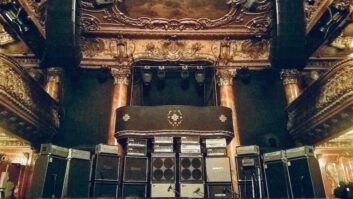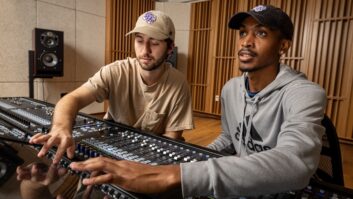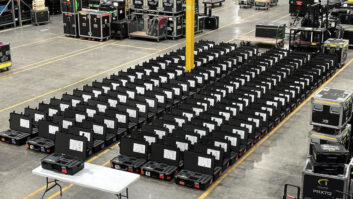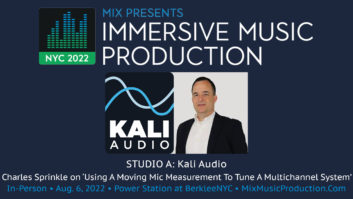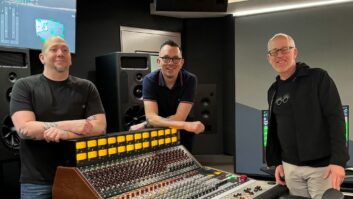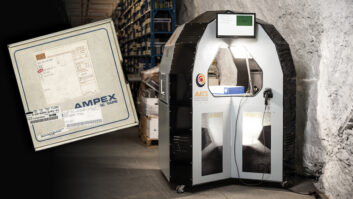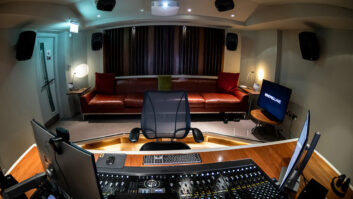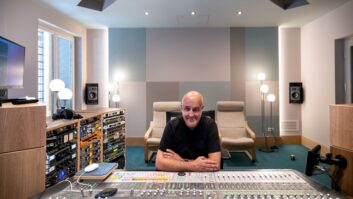Equipping a Project Studio for $10k, $25k, $50k
As Mix editors, our e-mail and voicemail bins are often filled to the breaking point with inquiries from readers who are either interested in upgrading their current recording gear or are taking their first steps into the home recording realm. In response to this, we ran our first “Building Your System” feature in July of 2000, which seemed to be well-received and answered many of those “what product is the best for me?” questions.
So here we are, almost two years later, and it’s time to revisit the subject to see what has changed and what has stayed the same. Our assistant editor Robert Hanson will again handle the $10k gear budget; contributing editor Michael Cooper checks into the $25k room; and our New York editor Paul Verna had $50k in imaginary cash to blow on toys. All prices quoted are a combination of list and street prices, and should only be used as a reference point.
Keep in mind that these three virtual facilities are just suggestions and are subject to the tastes and whims of the authors. Your mileage will vary, depending on your personal preferences, computer platforms you’re most comfortable with and the gear you already own.
THE $10K PROJECT STUDIO
In this day and age, $10,000 is more than enough cash to outfit a fully functional project studio inside of a bedroom or a den, or even in the corner of your living room. Obviously, there’s not enough budget for lavish acoustic treatment or that all-important Steinway grand. But there should be adequate money for a robust, computer-based recording rig that could handle anything from basic one-man-band applications to pre-production work and multimedia projects.
THE MAIN RIG
Because we’re building this studio from the ground up, the most logical starting point is the main computer, which will handle almost every aspect of the recording process. What I picked was a fully outfitted 733MHz Power Mac G4 with a final price tag of $3,348 (www.apple.com). Now after you pick your jaw up off the ground, here is what that includes: 1.5 GB of RAM, two 60GB Ultra ATA hard drives, a 15-inch Apple Studio Display and a DVD/CD-RW drive/burner. That covers all of my memory needs. It includes two dedicated hard drives (one for the OS and various applications and one for audio files). Furthermore, all of my CD burning and archiving needs are handled well into the foreseeable future. That leaves seven grand for everything from software to mics.
The audio interface is the next link in the chain. My pick is the MOTU 828 ($899). With one simple FireWire connection, I’ve got eight channels of ADAT I/O, RCA and S/PDIF, eight 24-bit balanced inputs and two mic pre’s. The 828 is also ASIO-compliant, and it will work with a dizzying array of audio applications.
There are three real options, as far as native workstations go, that offer professional features and expandability that won’t break the bank: Steinberg Cubase, Emagic Logic and MOTU Digital Performer. Here, it all comes down to personal preference; the real differences in the feature sets between these programs are almost nil — it’s like splitting hairs: one does this or that different or better than the other and vice versa. So my pick, because it’s the one I know the best, is Cubase VST 32 ($799). However, with any of these programs, you’ve got a winner.
As far as MIDI goes, everyone seems to be building their own purpose-built boxes that promise reliable timing when paired with that company’s native DAW. So, to keep it family, I’ve also picked up Steinberg’s Midex8 ($399), an 8×8 MIDI interface. And just to make the circle of emerging trends complete, the Houston VST Studio Controller ($1,599) will round out the set. I’m a sucker for reliability (and motorized faders), and by purchasing all of these products from the same company I know that I’m going to get the most bang for my buck.
As for plug-ins, the Waves Native Gold Bundle ($999) pretty much speaks for itself; you just can’t live without items like the C1 compressor and the L1 limiter. Antares Auto-Tune ($299) is another obvious choice. Some other audio/editing software I’d include is Recycle ($199) by Propellerheads and Spark by TC|Works ($399). These two programs are a perfect fit with Cubase: The Recycle REX file format can be directly imported into Cubase, and because of the VST standard, I can swap plug-ins between Cubase and Spark.
As far as synths go, I haven’t really found that I need too much beyond Propellerheads’ Reason ($399) and the handful of VST synths that come with Cubase. With that, all I need is a simple MIDI keyboard controller, and Roland, Yamaha and Midiman all offer units that fall in the $200 price range. After I plug in one MIDI cable, I’m ready to go. With the amount of RAM and processor speed from the G4, and the expandability of virtual synths, I’ll rarely be at a loss for a new bass patch or a snare drum sample.
LIFE OUTSIDE OF THE COMPUTER
As far as microphones go, you can really get by with very little these days. The Rode NT-1 ($349) is a great-sounding, entry-level condenser that works great on everything from lead vocals to acoustic instruments. Beyond that, a pair of Shure SM57s, which can be found for under $100 each, will provide me with more than enough variety and flexibility when it comes to recording vocals, percussion and miking guitar cabinets.
For monitoring, a pair of JBL LSR-25Ps ($399 each) and a set of Fostex T-40RP headphones ($129) will do the trick nicely. And for those sessions that have more than one set of ears, a Rolls HA43 Headphone Amp ($100) will provide another four headphone outputs.
OVER BUDGET
As I figure it, I’m about $1,000 over. Keep in mind, though, that these are list prices, and all of the items here (excluding the computer) retail for far less than what I’ve quoted. If I were to purchase these items in the real world, I’d have plenty of money left for cables, stands, a pop screen and other one-off items. So for a modest sum of cash, it’s possible to outfit a recording rig that is big on professional features and expandability, yet small enough to fit in a closet when you’ve got company.
— Robert Hanson
THE $25K PROJECT STUDIO
The specific gear needed to outfit a fully functional recording studio will vary depending on what you’re planning to do in the studio. As the owner of a commercial studio, I naturally think in terms of having enough mics and I/O to record a band consisting of drums, bass, guitars, a singer and possibly keyboards (or an equivalent number of musicians and instruments).
Let’s take a look at what $25,000 can buy to outfit such a studio. I’ll be citing approximate street prices in lieu of list prices for each piece of gear I recommend.
AT THE CORE
We’ll record to Mark of the Unicorn Digital Performer 3.x (DP3) digital audio sequencing software ($549). Because DP3 currently runs only on a Mac, we’ll pick up a dual-processor 800MHz G4 PowerMac ($3,499), which includes a built-in SuperDrive and 80GB Ultra ATA hard drive as standard features. The SuperDrive can write DVD-R, CD-R and CD-RW discs. You can install up to three optional hard drives in the dual-processor G4’s internal expansion bays. You’ll need a monitor, so let’s take home a 17-inch Apple Studio Display, a flat-panel LCD monitor that costs $999.
I prefer tracking and mixing with a digital mixer instead of using a mouse and keyboard. And, because a digital mixer can be used to monitor processed audio before sending it to the computer, latency is less than half of what it would be if you were to use an external data-control surface with Digital Performer (monitoring DP3’s throughput). Although it’s been around for several years, I still think the Yamaha 02RV2 ($5,350 base price) is the best digital mixer in its price class. Compared with less-expensive digital mixers, the 02RV2 offers the most simultaneously available, full-featured I/O and the number of bidirectional digital buses needed to concurrently record and monitor a large band. We’ll load up the 02RV2 with three CD8-TDII TDIF cards ($275/each) for 24-bit-capable digital I/O. (Unfortunately, the 02RV2’s ADAT Lightpipe cards can only pass 20-bit audio max.)
Together, our 02RV2’s three TDIF cards provide 24 channels of bidirectional digital I/O. We’ll need an I/O interface for the G4 PowerMac and DP3 to keep all those channels in the digital domain. The MOTU 2408mkII ($869) fits the bill perfectly, as it includes three TDIF connectors on its rear panel and ships with a PCI-324 card for I/O to/from the G4.
We’ll also need a way to get MIDI data in and out of the computer. MOTU’s MIDI Timepiece AV-USB ($495) does the trick nicely, providing a fully functioning, 8-in/8-out MIDI interface with MIDI patchbay and processing capabilities, including merging and filtering. The unit also provides wordclock out, reads and generates SMPTE in all formats, reads and generates MTC, and provides both USB and legacy serial ports for your Mac.
Using the above setup, DP3 sends MMC transport commands to the MIDI Timepiece AV-USB (MTP AV). In response, the MTP AV sends SMPTE out to the 02R and MTC out to DP3 for automation address lock. The MTP AV also serves as clock master, sending wordclock out to the 02R and 2408mkII (daisy-chained in series) to maintain digital sync.
LET’S HEAR IT
Active monitors have become all the rage, but I’ll go against the grain and recommend you pick up a pair of D.A.S. Monitor-8 passive monitors ($750/pair). The Monitor-8s are incredibly revealing reference monitors, offering superb transient response and imaging, ultra-flat frequency response above the mid-bass region and clarity that many monitors only dream of achieving. Add a Tannoy PS-110B Active Sub-Bass subwoofer ($379) to fill in the bottom two octaves, plus a Hafler P3000 Trans•Nova power amp ($550) to power the Monitor-8s, and you’ll have a head start on an extremely accurate monitoring system. At some point in the future, you’ll want to put some serious acoustic materials in your control room and tracking rooms, but budget constraints mean that’ll have to wait for now.
By the way, you won’t need a speaker switch box if you route your control room output signals to your Tannoy sub, out the sub’s pass-thru jacks and to the Hafler P3000 amp serving your Monitor-8 speakers.
For headphones, I recommend two Audio-Technica ATH-M40fs and two Audio-Technica ATH-D40fs studio headphones ($99 each). The M40s offer a frequency response tailored for singers and guitarists. The D40s (D for “drums”) deliver hyped bass and high frequencies that let the drummer and bassist hear themselves better, even while listening to the same cue mix as the rest of the band. Both headphone models offer excellent acoustic isolation and are loud enough to rip your head off, so you won’t have to worry about musicians complaining that they can’t hear themselves over the live drums. If the band has more than four members and you’re running out of headphones, then the bassist and keyboardist can record direct from inside the control room while listening to the Monitor-8s.
Also include a Rane HC6 headphone amp ($399) on your shopping list. It’s plenty loud, and it provides 12 headphone outputs; the extra outputs will come in handy when you buy more headphones and record larger bands.
MICS AND STANDS
We’ll buy a pair of AKG D-112 mics ($219/each) for kick drum and floor tom, and a pair of Sennheiser MD-421 II ($299) mics for rack toms. A couple of Neumann KM184 condenser mics ($549/each) will sound sweet on drum overheads, not to mention on all of the stringed instruments’ overdubs (such as acoustic guitar) you’ll record after basics are laid down. Be sure to pick up three Shure SM57 mics ($79/each) to record snare drum, electric guitar cabinet, and either a scratch vocal or a second electric guitar. Finally, an AKG C-414B-TLII large-diaphragm condenser mic ($860) can be used on the hi-hat while tracking basics and on the lead vocal during overdubs. One of the most under-rated and versatile mics on the market, the TLII offers deep bass extension and a highly detailed, open sound that’s particularly flattering on vocals, cello, floor tom, hi-hat, and stringed instruments such as acoustic guitar and mandolin.
Be sure to pick up eight AKG mic stands with boom arms ($59/each) and a couple of desktop mic stands ($29 with boom arm) to use with all the mics you bought.
HARDWARE SIGNAL PROCESSORS
For DI duties, pick up a Demeter VTDB-2b Tube Direct ($489). The Tube Direct is one of the best-sounding and most versatile tube DIs on the market.
Also pick up a Lexicon PCM 81 ($2,000) for digital reverb and multi-effects. Pro-quality reverbs are essential for great-sounding mixes, so we won’t scrimp here.
MAS PLUG-INS
You’ll want to add to the standard plug-ins MOTU ships with Digital Performer. The Waves Native Gold Bundle ($999) provides a host of extremely high-quality plug-ins: L1+ Ultramaximizer (which provides brickwall limiting/maximizing), stand-alone IDR dither (IDR is also available in the L1+), C1 Compressor/Gate, S1 Stereo Imager, Q10 10-Band ParaGraphic EQ, TrueVerb Reverb/Distance Processor, DeEsser, SuperTap 2-Tap Delay, SuperTap 6-Tap Delay, Renaissance Compressor, Renaissance EQ, Renaissance Reverberator, MaxxBass, UltraPitch 6-Voice PitchShifter, MetaFlanger, MondoMod, Doppler, Enigma (modulation, filtering and reverb), C4 Multiband Parametric Processor and PAZ Psycho-acoustic Analyzer.
Another must-have is Antares Auto-Tune MAS ($299), which will transparently process all of your off-key, monophonic vocals and instrumental tracks to perfect concert pitch.
FURNITURE AND CABLES
The Omnirax MixStation 02R ($1,100) provides a built-to-spec mix table for your 02RV2, plus much more. The MixStation 02R comes with flanking sidecars fitted with 19-inch rack rails that accommodate up to 42 one-rackspace pieces of gear, and is finished with shelf tops for placing your Monitor-8s. In the future, when your budget permits, you’ll want to get hefty, stand-alone speaker stands for your mains.
Tallying what we’ve bought so far, we’re left with roughly $1,292 for cables. Besides the obvious analog audio I/O cables, don’t forget to pick up three Yamaha TDIF-CABLE cables (for bi-directional digital I/O between the MOTU 2408mkII and Yamaha 02RV2), two Apogee WydeEye wordclock cables, two Apogee WydeEye S/PDIF digital audio cables (for digital 2-track mix I/O between the 02RV2 and 2408mkII) and a cable for your SMPTE feed to the 02R. Depending on the length and quality of the cables you buy, your budget might be maxed at this point. But if you still have enough money to pick up a Neutrik NYSSPP 48-way patchbay ($69) — and with some extra line and insert cables for connection to the bay — you’ll appreciate having access to your most-often-used analog I/O in one place.
— Michael Cooper
THE $50K PROJECT STUDIO
Half a generation ago, $50,000 could buy an aspiring recording artist a decent analog multitrack, a passable mixing desk, a few pieces of “prosumer” outboard gear, a respectable mastering deck and a handful of pretty good mics. In other words, a nice “demo” studio that could supplement a recording career but not afford the owner the luxury of working predominantly at home.
Today, thanks to advances in digital signal processing and storage, many musicians are able to record and mix their albums in their own studios, without spending a fortune on equipment.
That’s not to say that a personal studio does everything that a $2,000-per-day commercial facility does, but the results can be surprisingly comparable given a high level of skill and intelligent purchasing decisions on the home studio owner’s part.
For this hypothetical scenario, let’s assume a budget of $50,000 and the following criteria: The user is a serious musician/composer/programmer who wants to record, edit and mix master-quality tracks at home in an existing room that lends itself to this task; the studio owner is committed to digital recording but wants to maintain a strong analog presence in the front end of the recording chain to give the music a distinct sonic personality; the user wants to ensure a high degree of compatibility with other musicians, recording artists, engineers, studios, etc; and the studio should accommodate the live recording of small ensembles.
The first major decision to make is choosing a recording/editing/mixing system. Now that nonlinear editing is de rigueur in music production, I can’t find any rationale for a tape-based studio given the conditions set out above. Accordingly, I would make the case for a digital audio workstation as the facility’s centerpiece, supported by a nice complement of analog and digital technology.
Even though several companies offer compelling products, the workstation that remains the industry standard is Pro Tools. For that reason — and because of the system’s inherent strengths — I would build this studio around a Pro Tools rig. Specifically, I would jump headfirst on the high-sampling bandwagon and invest in the brand-spanking-new Pro Tools|HD system, introduced in January at the NAMM show. Available in three flavors — conveniently named 1, 2 and 3 — Pro Tools|HD sports a new, more powerful set of sound cards than its MIXplus predecessor; a new generation of hardware, including audio, MIDI and synchronization interfaces (and, eventually, remote-controllable preamps); and support for sampling rates up to 192 kHz.
Prior to the introduction of HD, I would have recommended to this hypothetical studio owner the industry-standard Pro Tools Mix3, which listed for $11,995. Coincidentally, the HD 3 system costs the same, and is more than twice the workstation.
For a hardware interface, I would go with the ultra-powerful 192 I/O for $3,995. A 24-bit converter capable of sampling rates up to 192 kHz, it features up to 50 channels of analog and digital I/O in various combinations (including AES, TDIF and ADAT digital formats); up to 16 tracks of simultaneous I/O with Pro Tools software; and older Digidesign audio interfaces compatibility.
Is this overkill for a personal studio on a limited budget? Not when taking into account the above criteria — the master-quality tracks, the sharing of projects, etc. Previously, 24-bit audio was the domain of the ultra-pro. MDMs just didn’t do that. Today, 24-bit is a universally accepted standard for audio production (notwithstanding the CD’s fixed wordlength of 16 bits).
Similarly, 96 kHz — and, by extension, 192 kHz — is becoming less of a luxury and more of a necessity among audio recordists across the spectrum. Anyone wishing to keep pace needs to embrace the high-sampling movement, asap.
For a computer, I wouldn’t settle for less than Apple’s top-of-the-line Dual 800MHz Power Mac G4, which lists for $3,500, and a $1,000 Apple 17-inch Studio Display. That brings us to a subtotal of $20,7490.
Until recently, you would have had to add several thousand dollars’ worth of SCSI storage and backup solutions to round out a system of that caliber. However, given that FireWire is well on its way to replacing SCSI as the protocol of choice, I would avoid SCSI altogether and invest in a Glyph Project X 60-gigabyte FireWire drive ($620). For most applications, this is plenty of space, but in case you need to temporarily move files over to another drive, your Mac’s built-in 80-gigabyte drive should suffice. (Digidesign does not recommend playing sessions from internal drives in a TDM system, but there’s no law against using your Mac for storage.)
Down the road, when you need hundreds of gigabytes of storage for your 192kHz files, someone will make a FireWire drive that’s within your budget.
In the meantime, the Mac’s built-in CD-R makes a good, industry-accepted backup device for most applications. In cases where the individual sound files are too long for a CD, a high-capacity tape drive, like an AIT or DDS unit, will do the trick. However, for the purposes of this studio, let’s make do with the CD-R.
Although Pro Tools offers MIDI sequencing, if you want to share projects with other musicians, then install Logic Audio Platinum ($800) and Digital Performer ($795) in your studio computer. These programs are extremely powerful, popular and versatile, and they integrate seamlessly with Digidesign hardware. At less than $1,000 each, they’re well worth the money.
Because $50,000 won’t buy you racks full of Pultecs, Fairchilds, LA-2As and 1176s, the plug-in equivalents will have to do. Without laboring over the specifics, let’s say that a plug-in budget of $3,000 is a good start to get such essentials as the Waves Gold Bundle, Auto-Tune, the McDSP suite and the Bomb Factory line of vintage emulators. Many other worthy models — like Amp Farm and the Focusrite line — usually get bundled with the Pro Tools system, depending on what promotion Digidesign is running at the time.
I’m showing a running total of $25,705, which means we’re about halfway there! And please feel free to check my math. I’m a music guy, not a numbers guy…
For the studio’s mixing desk, it’s a tough choice between a Pro Tools controller or a digital audio console. Although it would be lovely to have an analog console to add some personality to the studio, a board with the necessary audio quality and versatility is not within the budget.
Prior to the appearance of Pro Tools|HD, I would have argued that any number of 48kHz digital audio consoles would give the user more flexibility than a Pro Tools interface. However, given the dearth of affordable digital boards that sample at 96 kHz or above, I would go with a Digidesign controller, notably the Control|24.
Not only does this Ethernet-based controller provide 24 faders and virtually complete control of every Pro Tools parameter, it also has 16 Focusrite Platinum preamps, which address most — or possibly all — of this studio’s analog front end needs. At $7,995, Control|24 is not pocket change, but it’s a really good value considering the quality. We now stand at $33,700.
The preamps in the Control|24 are more than adequate, but for that singlemost important channel (the lead vocal? the lead guitar?), I would splurge on an Avalon VT-737, a preamp/compressor/EQ of the highest order. Its $2,295 price tag brings the subtotal to $35,995.
Once upon a time, a studio needed to invest a large chunk of its equipment budget on a mastering deck. After all, what good is a $200,000 console if the final mix gets recorded onto a crappy deck? In these days of mostly digital processing and mixing, the workstation becomes the mastering deck, with CD-R backups of the session and high-resolution sound files constituting the “part” that goes to the mastering house.
However, I would still recommend a real-time deck for quick-reference mixes. If DAT compatibility is important to you, then any number of pro DAT machines should do it. However, my vote goes to a real-time CD-R machine like the Tascam CDRW-700 ($749). Even if you don’t end up mixing to it, the CDRW-700 is a great reference CD player for your studio, especially if it’s digitally connected to your workstation.
For those of you keeping score, the subtotal is now $36,744. MIDI-wise, a $50,000 studio should provide all of the necessary solutions for a musician/composer who needs to create and edit MIDI files as well as interface with other MIDI-based musicians and engineers. The best catch-all solutions are the Korg Triton ($3,000 for a 61-note keyboard) and the Roland 5080 ($2,495). Both are extremely musical in their sound palettes and versatile in their programmability and compatibility. Connected to the studio via Digi’s new MIDI I/O ($595), the Triton and 5080 would more than suffice as synthesizers, drum machines, samplers and sound modules. Adding the two synths and the MIDI interface to our previous subtotal of $36,744, we now stand at $42,834. A few more shopping days left till downbeat!
That brings us to the more personal aspects of the studio: microphones, monitors, headphones and accessories.
For mics, the choices are virtually infinite and based almost entirely on personal preference. Given the budget, I would shoot for a compromise between quantity, quality and variety — i.e., a nice mix of dynamic mics, tube and transistor condensers, ribbons, large-diaphragm and small-diaphragm models, etc. My choices would be: Neumann TLM103 condenser with shock-mount ($1,215); Rode NT-2 large-diaphragm tube ($649); Shure SM57 and SM58 dynamics (“street” price of roughly $180 for both); AKG D-112 “kick drum” mic ($338); Audio-Technica 4051 small-diaphragm cardioid condenser ($700); and Coles 4038 ribbon ($1,135). The total mic budget: $4,217, for a running total of $47,051.
Monitors, similarly, are a personal choice. As long as they help you make the right mixing decisions, it doesn’t matter what speakers you use. With that said, I would recommend an affordable, pleasant-sounding, and widely used model for maximum compatibility; my choice would be the Mackie HR824s, for roughly $1,600 per pair.
Headphones are often an afterthought in recording studios, which is sadly ironic, given that the vast majority of recording is done while listening through headphones. For a personal studio, I would recommend two models that cover the gamut in terms of frequency response and volume: the Sony MDR-7506, which tends to sound bright and loud; and the AKG K-240M, which is mellower and softer. At $176 and $173, respectively, these industry workhorses are affordable and essential. (For the small-ensemble sessions I alluded to, the studio owner may have to implement a bring-your-own-cans policy.) With the Mackie monitors and Sony and AKG headphones factored in, our grand total is an even $49,000, fast approaching $50,000.
With the remaining grand, I would invest in some acoustical treatments to tighten up the room’s sound, which is bound to need tweaking. Without knowing the room, of course, it’s impossible to estimate how much one would have to spend to make it sound acceptable for recording, editing and mixing. However, assuming it’s a decent-sounding space with favorable dimensions, the Auralex Roominator Pro Plus, for $999, should be more than enough.
Well, now we’re exactly $1 short of the mark. Should we stop here and tape the lucky dollar bill to the studio wall? Naah. Let’s go a little further. After all, the figures I quoted were suggested list prices (except for the Shure SM57 and SM58, which were estimated “street” prices). Anyone who has bought anything from a pro audio shop knows that most retail outlets sell well below list. So, if you spec’d this exact studio from a dealer or group of dealers, then you would be likely to come up with a total closer to $40,000 rather than $50,000.
So, now that I gave myself license to stretch the credit card a little thinner, let me suggest the following finishing touches:
Today, no studio is complete without a broadband connection that will allow the home recordist to collaborate with other studio geeks throughout the globe, or send mixes for approval to faraway clients. In most areas, you can get a cable modem or DSL for an installation charge of $100 and a monthly fee of $60. Taken together and projected over the first year, the cost of broadband connectivity is $820. (If the home is already connected, then you can scratch the $820 off your list and substitute a cable router or hub, for anywhere from $50 to $300, depending on your needs.)
Throw in accessories like four K&M heavy-duty mic boom stands ($320 total), $500 worth of high-quality cabling (because your sound will only be as good as the weakest link in your signal path), a couple of pop filters ($40 total), sand bags for when you use the weighty Coles mic ($40) and a good USB hub ($70), and the grand, grand total is (drum roll, please)…$51,789.
Well, now that you just spent your life savings on a dream home studio, go make some music! It’s never too early to start recouping your investment.
Acknowledgment: Al Spinelli, sales manager at New York retail powerhouse B&H Pro Audio, provided invaluable assistance in devising the equipment list for this studio.
— Paul Verna
